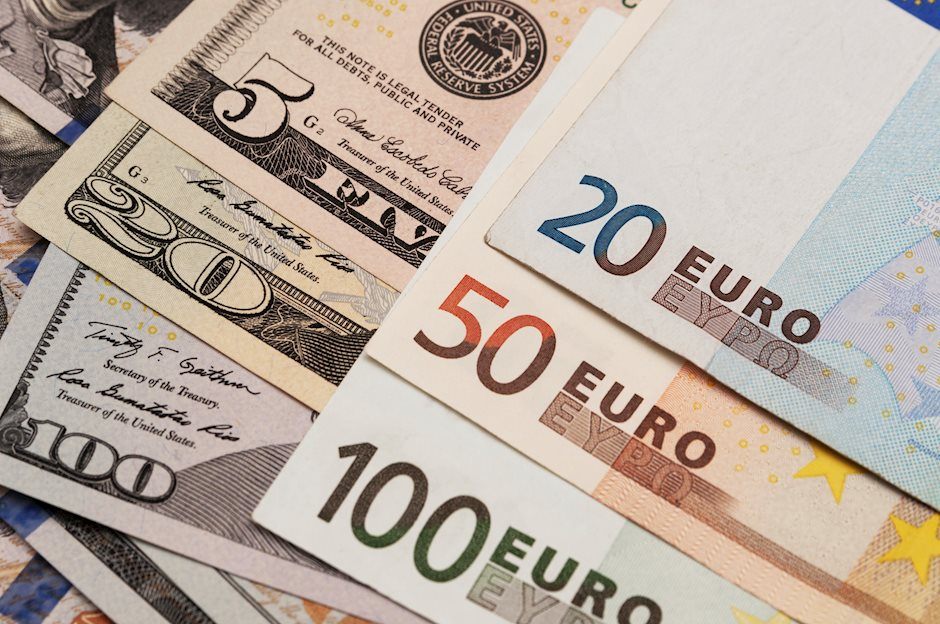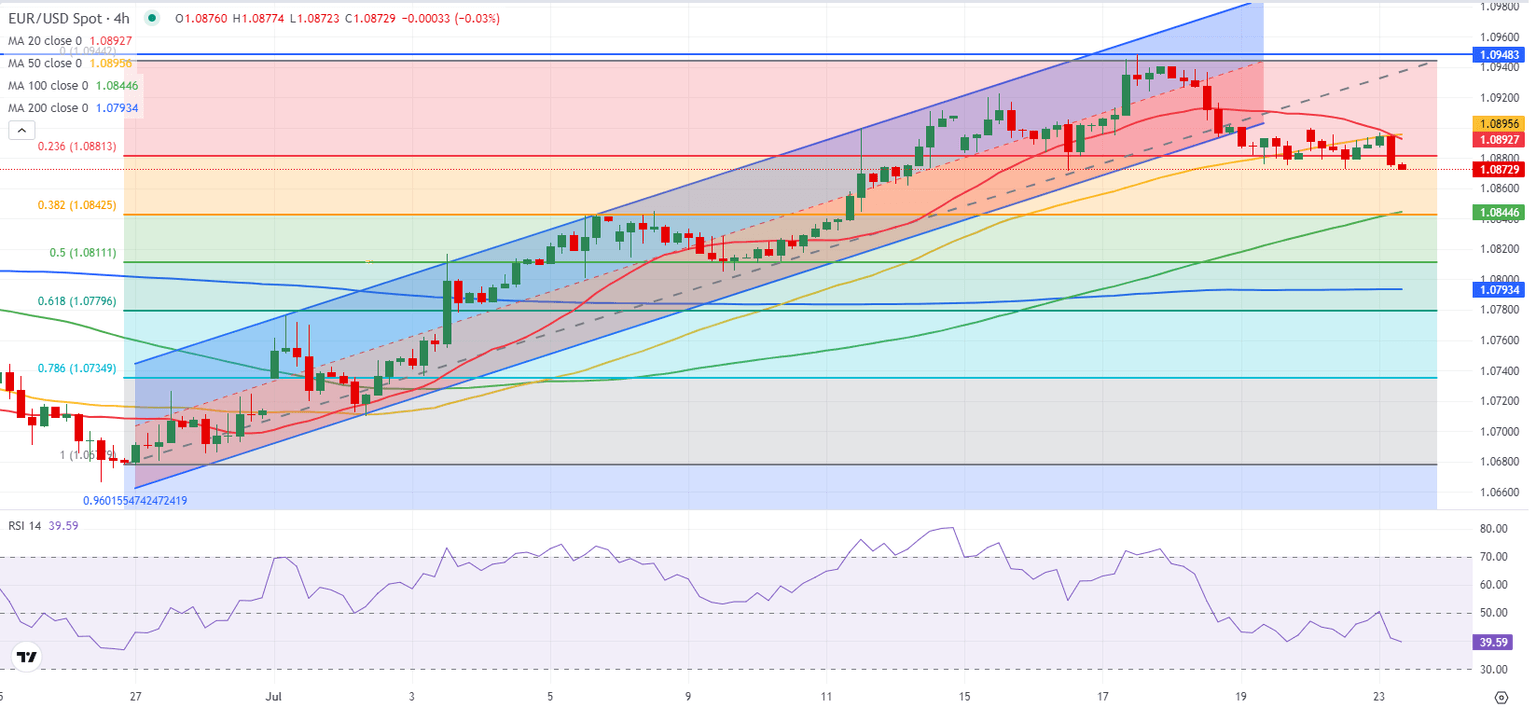EUR/USD Forecast: Euro tests key support level below 1.0900
- Euro stays under modest bearish pressure in the European morning on Tuesday.
- Technical sellers could show interest if 1.0880 support fails.
- EUR/USD could struggle to rebound in case risk mood sours.

EUR/USD registered small gains on Monday as the US Dollar (USD) struggled to find demand during the American trading hours. The pair, however, failed to gather recovery momentum and started to stretch lower in the European session on Tuesday.
Euro PRICE Today
The table below shows the percentage change of Euro (EUR) against listed major currencies today. Euro was the weakest against the Japanese Yen.
| USD | EUR | GBP | JPY | CAD | AUD | NZD | CHF | |
|---|---|---|---|---|---|---|---|---|
| USD | 0.16% | 0.16% | -0.62% | 0.09% | 0.31% | 0.29% | 0.08% | |
| EUR | -0.16% | 0.00% | -0.78% | -0.08% | 0.13% | 0.11% | -0.09% | |
| GBP | -0.16% | -0.00% | -0.77% | -0.07% | 0.15% | 0.12% | -0.10% | |
| JPY | 0.62% | 0.78% | 0.77% | 0.74% | 0.94% | 0.90% | 0.68% | |
| CAD | -0.09% | 0.08% | 0.07% | -0.74% | 0.21% | 0.18% | -0.03% | |
| AUD | -0.31% | -0.13% | -0.15% | -0.94% | -0.21% | -0.03% | -0.23% | |
| NZD | -0.29% | -0.11% | -0.12% | -0.90% | -0.18% | 0.03% | -0.22% | |
| CHF | -0.08% | 0.09% | 0.10% | -0.68% | 0.03% | 0.23% | 0.22% |
The heat map shows percentage changes of major currencies against each other. The base currency is picked from the left column, while the quote currency is picked from the top row. For example, if you pick the Euro from the left column and move along the horizontal line to the US Dollar, the percentage change displayed in the box will represent EUR (base)/USD (quote).
The risk-positive market atmosphere, as reflected by the more than 1% gain in the S&P 500 Index, made it difficult for the USD to stay resilient against its major rivals in the second half of the day on Monday. US stock index futures trade in negative territory early Tuesday, pointing to a negative shift in market mood.
In the absence of high-impact data releases, the USD could hold its ground if Wall Street's main indexes turn south following Monday's bullish action. After the closing bell, tech-giants, such as Google (Alphabet) and Tesla, will report second-quarter earnings. Hence, investors could remain cautious while waiting for key earnings figures.
In the meantime, dovish comments from European Central Bank (ECB) officials don't allow the Euro to attract buyers. On Monday, ECB policymaker Peter Kazimir said the market pricing of two rate cuts by the end of 2024 was not "entirely misplaced." Meanwhile, Vice President Luis de Guindos said on Tuesday that recent inflation data from the Euro area were in line with their projections.
EUR/USD Technical Analysis
EUR/USD closed the last 4-hour candle below 1.0880, where the Fibonacci 23.6% retracement level of the latest uptrend is located. Once this level is confirmed as resistance, the pair could extend its slide toward 1.0840 (100-period Simple Moving Average (SMA), Fibonacci 38.2% retracement) and 1.0810-1.0795 (Fibonacci 50% retracement, 200-period SMA).
If EUR/USD manages to reclaim 1.0880, 1.0900 (psychological level, static level, 50-period SMA) could be seen as interim resistance before 1.0950 (end point of the uptrend).
Euro FAQs
The Euro is the currency for the 20 European Union countries that belong to the Eurozone. It is the second most heavily traded currency in the world behind the US Dollar. In 2022, it accounted for 31% of all foreign exchange transactions, with an average daily turnover of over $2.2 trillion a day. EUR/USD is the most heavily traded currency pair in the world, accounting for an estimated 30% off all transactions, followed by EUR/JPY (4%), EUR/GBP (3%) and EUR/AUD (2%).
The European Central Bank (ECB) in Frankfurt, Germany, is the reserve bank for the Eurozone. The ECB sets interest rates and manages monetary policy. The ECB’s primary mandate is to maintain price stability, which means either controlling inflation or stimulating growth. Its primary tool is the raising or lowering of interest rates. Relatively high interest rates – or the expectation of higher rates – will usually benefit the Euro and vice versa. The ECB Governing Council makes monetary policy decisions at meetings held eight times a year. Decisions are made by heads of the Eurozone national banks and six permanent members, including the President of the ECB, Christine Lagarde.
Eurozone inflation data, measured by the Harmonized Index of Consumer Prices (HICP), is an important econometric for the Euro. If inflation rises more than expected, especially if above the ECB’s 2% target, it obliges the ECB to raise interest rates to bring it back under control. Relatively high interest rates compared to its counterparts will usually benefit the Euro, as it makes the region more attractive as a place for global investors to park their money.
Data releases gauge the health of the economy and can impact on the Euro. Indicators such as GDP, Manufacturing and Services PMIs, employment, and consumer sentiment surveys can all influence the direction of the single currency. A strong economy is good for the Euro. Not only does it attract more foreign investment but it may encourage the ECB to put up interest rates, which will directly strengthen the Euro. Otherwise, if economic data is weak, the Euro is likely to fall. Economic data for the four largest economies in the euro area (Germany, France, Italy and Spain) are especially significant, as they account for 75% of the Eurozone’s economy.
Another significant data release for the Euro is the Trade Balance. This indicator measures the difference between what a country earns from its exports and what it spends on imports over a given period. If a country produces highly sought after exports then its currency will gain in value purely from the extra demand created from foreign buyers seeking to purchase these goods. Therefore, a positive net Trade Balance strengthens a currency and vice versa for a negative balance.
Premium
You have reached your limit of 3 free articles for this month.
Start your subscription and get access to all our original articles.
Author

Eren Sengezer
FXStreet
As an economist at heart, Eren Sengezer specializes in the assessment of the short-term and long-term impacts of macroeconomic data, central bank policies and political developments on financial assets.


















